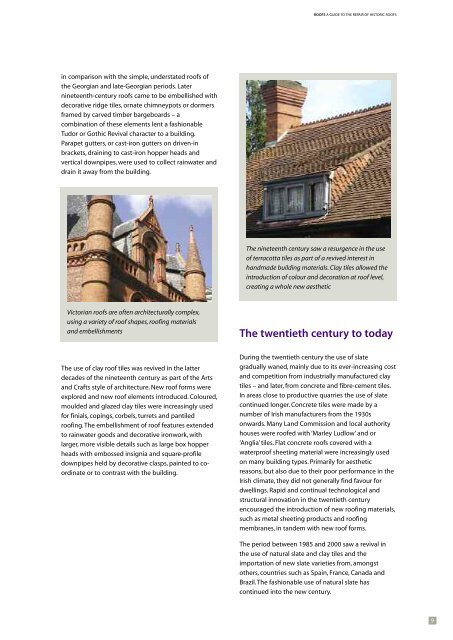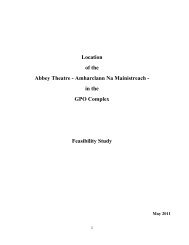A Guide to the Repair of Historic Roofs - Dublin City Council
A Guide to the Repair of Historic Roofs - Dublin City Council
A Guide to the Repair of Historic Roofs - Dublin City Council
Create successful ePaper yourself
Turn your PDF publications into a flip-book with our unique Google optimized e-Paper software.
ROOFS A GUIDE TO THE REPAIR OF HISTORIC ROOFSin comparison with <strong>the</strong> simple, understated ro<strong>of</strong>s <strong>of</strong><strong>the</strong> Georgian and late-Georgian periods. Laternineteenth-century ro<strong>of</strong>s came <strong>to</strong> be embellished withdecorative ridge tiles, ornate chimneypots or dormersframed by carved timber bargeboards – acombination <strong>of</strong> <strong>the</strong>se elements lent a fashionableTudor or Gothic Revival character <strong>to</strong> a building.Parapet gutters, or cast-iron gutters on driven-inbrackets, draining <strong>to</strong> cast-iron hopper heads andvertical downpipes, were used <strong>to</strong> collect rainwater anddrain it away from <strong>the</strong> building.The nineteenth century saw a resurgence in <strong>the</strong> use<strong>of</strong> terracotta tiles as part <strong>of</strong> a revived interest inhandmade building materials. Clay tiles allowed <strong>the</strong>introduction <strong>of</strong> colour and decoration at ro<strong>of</strong> level,creating a whole new aes<strong>the</strong>ticVic<strong>to</strong>rian ro<strong>of</strong>s are <strong>of</strong>ten architecturally complex,using a variety <strong>of</strong> ro<strong>of</strong> shapes, ro<strong>of</strong>ing materialsand embellishmentsThe twentieth century <strong>to</strong> <strong>to</strong>dayThe use <strong>of</strong> clay ro<strong>of</strong> tiles was revived in <strong>the</strong> latterdecades <strong>of</strong> <strong>the</strong> nineteenth century as part <strong>of</strong> <strong>the</strong> Artsand Crafts style <strong>of</strong> architecture. New ro<strong>of</strong> forms wereexplored and new ro<strong>of</strong> elements introduced. Coloured,moulded and glazed clay tiles were increasingly usedfor finials, copings, corbels, turrets and pantiledro<strong>of</strong>ing. The embellishment <strong>of</strong> ro<strong>of</strong> features extended<strong>to</strong> rainwater goods and decorative ironwork, withlarger, more visible details such as large box hopperheads with embossed insignia and square-pr<strong>of</strong>iledownpipes held by decorative clasps, painted <strong>to</strong> coordinateor <strong>to</strong> contrast with <strong>the</strong> building.During <strong>the</strong> twentieth century <strong>the</strong> use <strong>of</strong> slategradually waned, mainly due <strong>to</strong> its ever-increasing costand competition from industrially manufactured claytiles – and later, from concrete and fibre-cement tiles.In areas close <strong>to</strong> productive quarries <strong>the</strong> use <strong>of</strong> slatecontinued longer. Concrete tiles were made by anumber <strong>of</strong> Irish manufacturers from <strong>the</strong> 1930sonwards. Many Land Commission and local authorityhouses were ro<strong>of</strong>ed with ‘Marley Ludlow’ and or‘Anglia’ tiles. Flat concrete ro<strong>of</strong>s covered with awaterpro<strong>of</strong> sheeting material were increasingly usedon many building types. Primarily for aes<strong>the</strong>ticreasons, but also due <strong>to</strong> <strong>the</strong>ir poor performance in <strong>the</strong>Irish climate, <strong>the</strong>y did not generally find favour fordwellings. Rapid and continual technological andstructural innovation in <strong>the</strong> twentieth centuryencouraged <strong>the</strong> introduction <strong>of</strong> new ro<strong>of</strong>ing materials,such as metal sheeting products and ro<strong>of</strong>ingmembranes, in tandem with new ro<strong>of</strong> forms.The period between 1985 and 2000 saw a revival in<strong>the</strong> use <strong>of</strong> natural slate and clay tiles and <strong>the</strong>importation <strong>of</strong> new slate varieties from, amongs<strong>to</strong><strong>the</strong>rs, countries such as Spain, France, Canada andBrazil. The fashionable use <strong>of</strong> natural slate hascontinued in<strong>to</strong> <strong>the</strong> new century.9
















